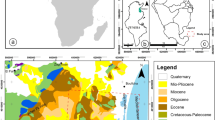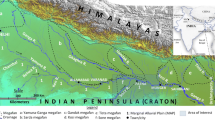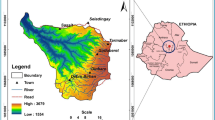Abstract
The present study used bore-well litholog data from six locations (Badampora, Telbal, Cheshmashai, Batwara, Karannagar and Bemina) to map the aquifers and its possible geometry in parts of Srinagar and Ganderbal districts, Kashmir valley, India. From the available data, a fence diagram was generated that depicted the occurrence of a 2–32 m thick upper alluvial layer of regional scale underlain by a 2–10 m thick sandy-silt horizon. Underlying this, a regional sandy horizon varying in thickness from 3 m (Telbal and Batwara) to 11 m (Bemina) is present at a depth of 7 m (at Badampora) to 32 m (at Bemina) below the ground level. The sandy stratum is followed by a number of granular horizons comprising alternate coarser sediments with clay as matrix at varying depths. Except the sandy stratum, the other litho-horizons/aquifers indicated heterogeneity and pinching character with a significant variation in nature and geometry from place to place both vertically and horizontally, thereby leading to wide variation in the water availability. Overall, the sub-surface horizons exhibit gradation from coarse detrital sediments (gravel, pebble, boulder and coarse sand) in NE-NW parts to fine sediments (clay, silt, and fine sand) in SE-SW parts of the area. The sandy stratum along with the overlying sandy silt horizon overlain by a regional clay blanket is probably acting as a single aquifer system providing a significant and potential groundwater resource in the area. The water bearing horizons in the upper sub-surface levels exists essentially under unconfined conditions while at deeper sub-surface levels water bearing aquifers exist under confined to semi-confined conditions. The general groundwater movement originates from N-NE upland areas towards S-SW lowland areas, almost replicating the local topography and the general slope of the area. Furthermore, the chemical quality analysis suggested that the groundwater is safe for drinking purposes and suitable for agricultural uses in this area.
Similar content being viewed by others
References
APHA (2001) Standard methods for the examination of water and waste. American Public Health Association, Washington DC.
Bhat, M.Y., Mir, R.A. (2014) Medical Geology: A Case Study of Kashmir. Jour. Cent. Asian. Stud., v.XXI.
BIS (2012) Indian Standard Specification for drinking water, Indian Standards Institute, IS: 10500.
Census Report (2011) Districit census book, Srinagar, p 26.
CGWB (2013) Government of India, Ministry of Water Resources, Central Ground Water Board, Ground water information booklet of Srinagar district, Jammu & Kashmir, pp 1–17.
DGM (2017) District Survey report of Srinagar district, Geology and Mining, Jammu and Kashmir, pp18–20.
Freeze, R.A., Cherry, J.A. (1979) Groundwater. New Jersey: Prentice-Hall.
Hussain, M. (2005) Geography of Jammu and Kashmir, 4th edition, Rajesh Publications New Delhi.
Jeelani, G.H., Rouf, A.S., Aadil, H. (2014) Hydrogeochemical assessment of groundwater in Kashmir Valley, India. Jour. Earth Syst. Sci., v.123(5), pp.1031–1043.
Lone, K.A., Mir, R.A. and Bhat, N.A. (2021) Geochemical Characterization and Evolution of Groundwater in Parts of Kashmir Valley, Western Himalaya. In: A.K. Taloor et al. (Eds.), Water, Cryosphere, and Climate Change in the Himalayas, Geography of the Physical Environment. Springer Nature Switzerland AG 2021. DOI: https://doi.org/10.1007/978-3-030-67932-3_17
Mir, R.A., Jeelani, G. (2015a) Hydrogeochemical assessment of river Jhelum and its tributaries for domestic and irrigation purposes, Kashmir valley, India. Curr. Sci., v.109(2), pp.311–322.
Mir, R. A. and Jeelani, G. (2015b) Textural characteristics of sediments and weathering in river Jhelum basin located in Kashmir valley western Himalaya. Jour. Geol. Soc. India, v.86(4), pp.445–458.
Mir, R. A., Jeelani, G. and Dar, F A. (2016) Spatio-temporal variations and factors controlling the hydrogeochemistry of river Jhelum located in Kashmir valley, western Himalayas. Environ. Monit. Assess., v.188, pp.438.
Mir, R.A. and Lone, K. (2020) a recent scenario of groundwater quality in Kashmir, northwest Himalaya, India. Springer Nature Switzerland AG. In: R.A. Bhat, K. R. Hakeem (Eds.), Bioremediation and Biotechnology, v.4, DOI:https://doi.org/10.1007/978-3-030-48690-7_3.
Mir, R.A., Dar, F. A., and Jeelani, G. (2021) Chemical Weathering in Jhelum River and its Tributaries, Kashmir Basin, Western Himalaya. In: A.K. Taloor et al. (Eds.), Water, Cryosphere, and Climate Change in the Himalayas, Geography of the Physical Environment. Springer Nature Switzerland AG 2021. DOI: https://doi.org/10.1007/978-3-030-67932-3_13
Rashid, I., Romshoo, S.A., Amin, M., Khanday, S.A., Chauhan, P. (2017) Linking human-biophysical interactions with the trophic status of Dal Lake, Kashmir Himalaya, India. Lim. Ecol. Manag. Inland Water, v.62, pp.84–96.
Reddy, P.R., Vinod, K. and Seshadri, K. (1996) Use of IRS-1C data in groundwater studies. Curr. Sci., v70, pp.600–605.
Sander, P., Chesley, M.M. and Minor, T.B. (1996) Groundwater assessment using remote sensing and GIS in a rural groundwater project in Ghana: Lessons learned. Hydrogeol. Jour., v.4, pp.40–49.
Sawyer, C.N. and McCarty, P.L. (1967) Chemistry for sanitary engineers, 2nd ed., McGraw-Hill, New York, p.518.
Singhal, D.C., Israil, M., Sharma, V.K. and Kumar, B. (2010) Evaluation of groundwater resource and estimation of its potential in Pathri Rao watershed, district Haridwar (Uttarakhand). Curr. Sci., v.98(2), pp.25.
Srivastava, A. (2005) Aquifer geometry, basement — topography and ground-water quality around Ken Graben, India. Jour. Spat. Hydrol., v.2(2), pp.1–7.
Subba, R.N. (2006) Seasonal variation of groundwater quality in a part of Guntur District, Andhra Pradesh, India. Environ. Geol., v.49, pp.413–429.
Tait, N.G., Davison, R.M., Whittakar, J.J., Leharne, S.A. and Lerner, D.N. (2004) Borehole optimization system (BOS) — a GIS based risk analysis tool for optimizing the use of urban groundwater. Environ. Model. Soft., v.19, pp.1111–1124.
Todd, D.K. and Mays, L.W. (2005) Groundwater Hydrology, 3rd edn. New York: John Wiley & Sons.
USEPA (1976) US Environmental Protection Agency Quality criteria for water. Washington, DC, pp.501
WHO (2006) International standards for drinking water. World Health Organization, Geneva.
Acknowledgements
Khurshid Ahmad Lone would like to thank HoD, Department of Geology and Geophysics, and Director, CORD (Centre for Research and Development) Kashmir University, Srinagar and Department of Geology and Mining (DGM), Srinagar for their support during the M.Phil work.
Author information
Authors and Affiliations
Corresponding author
Rights and permissions
About this article
Cite this article
Lone, K.A., Mir, R.A. A Preliminary Study on Aquifers and its Possible Geometry in Parts of Kashmir Valley, India. J Geol Soc India 97, 772–780 (2021). https://doi.org/10.1007/s12594-021-1759-2
Received:
Accepted:
Published:
Issue Date:
DOI: https://doi.org/10.1007/s12594-021-1759-2




